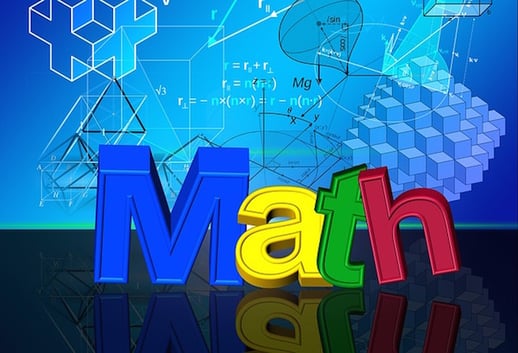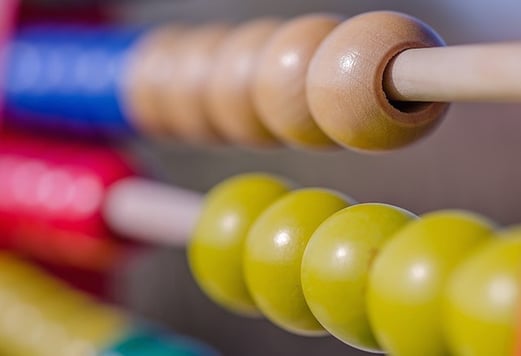
While the prohibition of a calculator on some SAT Math questions might leave you worried, rest assured that you don't need a calculator on this section. In fact, having one would probably just slow you down!
This guide will discuss the third section of the SAT: the Math with No Calculator section. Read on to learn the types of questions you can expect to see and how you can get a high score. But first, let's go over the format of the SAT Math No Calculator section.
How Is the SAT Math No Calculator Section Formatted?
Let's start with the basics: how much time you have and how the SAT Math No Calculator section is structured.
This section always comes third, after the Reading and Writing and Language sections. It's only 25 minutes long, making it the shortest section on the SAT. After you complete this section, you'll get a short five-minute break, at which time you can take out your calculator and start to get ready for the next section: Math Calculator.
You'll be asked to answer 20 questions. You'll have an average of one minute and fifteen seconds, or 75 seconds, per question. Of these questions, 15 will be multiple choice (each with four answer choices) and five will be grid-ins (also known as student-produced responses). You'll fill in your answers to these five grid-ins on a special section of your answer sheet.
Here's how the Math No Calculator section breaks down exactly:
| Total Time | # of Multiple-Choice Questions | # of Grid-ins | Time per Question |
| 25 minutes | 15 (#1-15) | 5 (#16-20) | 75 seconds |
Since the No Calculator section is the shorter of the two Math sections, it will only count for one-third of your total Math score. Now, let's move beyond logistics and discuss the skills that will be tested on the SAT Math No Calculator section.

You don't need a calculator to answer these questions—just a pencil and paper!
What Skills Are Tested on the Math No Calculator Section?
According to the College Board, the Math No Calculator section tests two major categories: Heart of Algebra and Passport to Advanced Math, along with problems that fall under Additional Topics. These categories focus on concepts such as linear equations, linear inequalities, functions, quadratic equations, graphs, geometry, and complex numbers.
Unlike on the Calculator section, there are no Problem Solving and Data Analysis questions on the No Calculator section—these are the ones for which you must interpret data from tables and scatterplots or calculate ratios, rates, and proportions. The chart below shows exactly how many questions you can expect to find in each of the three major skills areas:
| Content Categories | # of Questions | % of No Calculator Section |
| Heart of Algebra | 8 | 40% |
| Passport to Advanced Math | 9 | 45% |
| Additional Topics | 3 | 15% |
Source: Official SAT Study Guide
Some questions have multiple steps and require you to combine two or more concepts to work toward a solution.
To gain a sense of how the Math No Calculator section tests the above skills, you can find official SAT sample questions below. Let's take a look at how this calculator-free section tests these skill areas.

This amphibian romantic wears his Heart of Algebra on his sleeve.
How Does the Math No Calculator Section Test Your Skills?
The Math No Calculator section won't ask you to do long, complex calculations out by hand. For the most part, this section seeks to test your reasoning and problem-solving abilities.
The College Board wants to ensure that you understand fundamental math concepts and don't need to rely on a calculator to reach a solution. There will still be some arithmetic—e.g., basic adding, subtracting, multiplying, and dividing by decimals—but the majority of the problems will focus more on reasoning than on figures.
Below are some official sample No Calculator questions. You'll find two questions that fall into the Heart of Algebra category, two in Passport to Advanced Math, and one in Additional Topics. Notice how, for the most part, a calculator wouldn't actually be useful at all for reaching your answer.
The questions below are borrowed from the College Board's collection of official SAT practice tests, a free resource that should definitely be part of your test prep. I also suggest checking out Khan Academy's SAT resources, though they shouldn't be a replacement for more thorough test prep.
#1: Heart of Algebra
This Heart of Algebra question asks you to solve for $x$ in an algebraic equation:
If ${x-1}/3=k$ and $k=3$, what is the value of $x$?
A) 2
B) 4
C) 9
D) 10
To solve this problem, you could go through the following steps:
#1: Multiply both sides by 3, so you're working with $x - 1 = 3k$
#2: Add 1 to both sides, leaving you with $x = 3k + 1$
#3: Then solve for $x$ by substituting $k$ with 3. Since $x = 3k + 1$, $x = 3(3) + 1$, or $x = 10$.
This Heart of Algebra example represents an easy-level question. If you didn't solve for $x$, you could instead plug in the answer choices and work backward (i.e., which value of $x$ would equal 3). Either way you decide to solve it, this problem definitely doesn't require the use of a calculator.
Answer: D
#2: Heart of Algebra
The following Heart of Algebra question is of medium difficulty; it tests your reasoning skills and understanding of an algebraic expression. While you could plug in numbers to make the scenario more concrete, the easiest way to solve this problem is to understand how to represent rates with algebraic variables.
On Saturday afternoon, Armand sent $m$ text messages each hour for 5 hours, and Tyrone sent $p$ text messages each hour for 4 hours. Which of the following represents the total number of messages sent by Armand and Tyrone on Saturday afternoon?
A) $9mp$
B) $20mp$
C) $5m+4p$
D) $4m+5p$
This problem asks about the total number of messages Armand and Tyrone sent:
- The total number of texts Armand sent is his rate ($m$ texts/hour) multiplied by the number of hours (5). Your product for Armand's texts is 5$\bi m$.
- The total number of texts Tyrone sent is his rate ($p$ texts/hour) multiplied by the number of hours (4). Your product for Tyrone is 4$\bi p$.
- To get a total, you would add these two products together, leaving you with 5$\bi m$ + 4$\bi p$.
If you were unsure about your answer, you could plug in sample numbers for $\bi m$ and $\bi p$ to check your reasoning. The easiest way to solve this problem, though, is to conceptually understand the relationship between rates and time, and how to represent this relationship with variables.
Answer: C
#3: Passport to Advanced Math
This sample question tests your ability to manipulate an algebraic equation:
$$m={({r}/{1,200})(1+{r}/{1,200})^N}/{(1+{r}/{1,200})^N-1}P$$
The formula above gives the monthly payment $m$ needed to pay off a loan of $P$ dollars at $r$ percent annual interest over $N$ months. Which of the following gives $P$ in terms of $m$, $r$, and $N$?
A) $P={({r}/{1,200})(1+{r}/{1,200})^N}/{(1+{r}/{1,200})^N-1}m$
B) $P={(1+{r}/{1,200})^N-1}/{({r}/{1,200})(1+{r}/{1,200})^N}m$
C) $P=({r}/{1,200})m$
D) $P=({1,200}/{r})m$
The initial expression gives you $m$ in terms of $r$, $N$, and $P$. The problem asks you to solve for $P$ in terms of $m$, $r$, and $N$.
To switch around the equation, multiply both sides by the reciprocal of the expression beside $P$. Basically, you can just flip the current expression, which gives you answer choice B.
Answer: B
Ready to go beyond just reading about the SAT? Then you'll love the free five-day trial for our SAT Complete Prep program. Designed and written by PrepScholar SAT experts, our SAT program customizes to your skill level in over 40 subskills so that you can focus your studying on what will get you the biggest score gains.
Click on the button below to try it out!
#4: Passport to Advanced Math
The question below is the first example that requires arithmetic. While a calculator would be helpful here, the College Board wants to see that you can perform addition, subtraction, division, multiplication long hand.
$b=2.35+0.25x$
$c=1.75+0.40x$
In the equations above, $b$ and $c$ represent the price per pound, in dollars, of beef and chicken, respectively, $x$ weeks after July 1 during last summer. What was the price per pound of beef when it was equal to the price per pound of chicken?
A) $\$ 2.60$
B) $\$ 2.85$
C) $\$ 2.95$
D) $\$ 3.35$
Since this problem asks when the price per pound of beef ($\bi b$) was equal to the price per pound of chicken ($\bi c$), you can solve it by setting $b$ as equal to $c$, or $2.35 + 0.25x = 1.75 + 0.40x$.
Then, you solve for $x$ with these steps:
#1: To avoid negative numbers, subtract 1.75 from both sides and $\bo 0.25\bi x$ from both sides. This leaves you with $0.60 = 0.15x$.
#2: Divide both sides by $0.15$ to get $x = 4$.
#3: The question asks about the price per pound of beef when both meats were equal, so plug in $x$ to solve for $b$. Your equation should look like this: $b = 2.35 + 0.25(4)$.
#4: $b = 2.35 + 0.25(4) = 2.35 + 1 = 3.35$.
#5: The price per pound of beef when it was equal to the price per pound of chicken was $3.35.
Answer: D
#5: Additional Topics in Math
Finally, the following is an Additional Topics question that involves geometry (right triangles) and basic trigonometry. Here, you need to demonstrate an understanding of sin and cosine and how they relate to one another in a right triangle. Without knowing this relationship, you'd have a tough time answering this question.
In a right triangle, one angle measures $x°$, where sin $x°=4/5$. What is cos$(90°-x°)$?
The easiest way to solve this problem is to recall the complementary angle relationship of sine and cosine: sin($\bi{x}$°) $=$ cos($\bo 90$° $\bo − \bi x$°). If you can recall this, you'll immediately know—without having to do any calculations—that your answer is $\bo{4}/ \bo{5}$.
Answer: $4/5$ or $0.8$
As you can see, the No Calculator questions ask you to demonstrate a deep understanding of mathematical concepts. So how can you study to ensure that you comprehend these challenging questions? Read on for some study tips to use as you prepare for SAT Math.

Let's talk strategy.
How to Do Well on the Math No Calculator Section: 5 Tips
Any prep you do for the Math No Calculator section will help you on the Math Calculator section as well. The following study tips, though, are especially essential for the No Calculator section.
Tip 1: Study Key Concepts
As you saw in the example questions above, many questions won't ask you to do any calculations with numbers; instead, they'll require you to have deep knowledge of the underlying concepts and be able to apply operations to work toward a solution. In this way, some of the problems are more abstract and theoretical rather than based on figures and equations with real numbers.
This shift, by the way, aligns more closely with the Common Core. Both the SAT and the Common Core standards now present math with fewer topics that are more in-depth. Some SAT critics have pointed out that this shift continues to benefit students who attend better-resourced schools whose teachers are well versed in the Common Core. If your math classes teach a curriculum that aligns with Common Core standards, then they should be teaching you key concepts in a way that will help you on the SAT Math No Calculator section.
Outside of school, make time to study the key topics that will appear on SAT Math. Because of the College Board's recent commitment to transparency, it shares exactly what those concepts will be. Algebra is especially important, and you'll want to ensure you have a firm grasp of topics like linear and nonlinear equations, quadratic equations, and functions.
Beyond the main topics shared by the College Board, make sure your SAT Math study materials break down each broad topic into its component subtopics. By covering each detail, you can fill in any gaps in knowledge. On this section, you can't rely on a calculator to do any of the thinking for you; you need to show up with a strong understanding of the key concepts.
Tip 2: Practice Close Reading
Just as No Calculator problems emphasize your conceptual understanding over your ability to manipulate figures and carry out calculations, they also test your reading comprehension. You'll have to be able to read a problem and figure out what steps it's asking you to take.
Word problems especially can be relatively involved, sometimes containing more information than is necessary for you to work toward a solution. That means it's up to you to figure out which details are relevant and which aren't. Some of these problems, according to the College Board, feature real-world scenarios, such as calculating gas mileage or converting from one country's currency to another.
Of course, not all these real-world scenarios are part of everybody's actual everyday experiences. Practice problems will help get you familiar with the types of scenarios that the College Board considers to be real world.
Critics have suggested that this emphasis on word problems—along with the above mentioned alignment with the Common Core—could disadvantage some test takers, especially those who speak English as a second language.
To prep for this section's emphasis on reading comprehension, make sure to study with multi-step word problems.

FAQ: Can I use my abacus during the No Calculator section? Sadly, no—you'll have to rely on your own counting skills.
Tip 3: Brush Up on Your Arithmetic Skills
For the most part, the No Calculator section prioritizes a conceptual understanding over the ability to carry out calculations. There are still a handful of problems, though, that will require you to do arithmetic. Without a calculator, you'll have to be able to write out these calculations and solve them by hand.
In example problem #4 above, for instance, you'd have to subtract and divide using decimal points. Although these are basic math skills, many students have likely grown used to performing these simple calculations on a calculator. As a result, you'll want to brush up on your ability to write these operations out by hand quickly, efficiently, and with an eye for accidental mistakes.
Tip 4: Show Your Work
If you've been in any math class, you're probably familiar with the much repeated math teacher mantra: show your work. Teachers don't want you to seemingly pull an answer out of thin air; they want you to write out, step by step, how you worked through a problem. Not only does this demonstrate your understanding, but it also helps you catch any mistakes along the way.
Just as you should write out any calculations you do, you should also write out the steps in other problems, whether you're solving for $x$ or simplifying a multi-variable expression. Many of the No Calculator problems require multiple steps, so writing out your work will help you keep track of your thinking and avoid errors.
Tip 5: Answer Hundreds of Practice Problems
Answering practice problems should go hand in hand with reviewing key topics. Make sure you're comfortable with the concepts and know when and how to apply them to realistic SAT problems. Taking timed practice tests will also help you develop your time-management skills and your ability to answer questions quickly and accurately.
So where can you find all these practice problems? One place, of course, is the College Board. You can find automatically graded online practice questions and eight free official practice tests, which you can download and print out. You can also find problems of varying difficulty levels on Khan Academy, along with video explanations of the different concepts. Other options include SAT Math prep books and PrepScholar's SAT prep program.
Finally, you can use practice tests for the old SAT, as long as you make sure to adjust your focus for the current version of the SAT. (For instance, you'll find fewer geometry problems on the SAT now but will need to add in some basic trigonometry practice.)
After you answer questions and take timed tests, analyze your results. Figure out exactly why you got a question wrong and what you can do to fix your mistake next time. If you lacked core knowledge, study those concepts. If you made careless errors, work on your strategies for time management. Walk yourself through the answer explanations step by step to figure out how you can improve.
By analyzing your results and using practice tests as valuable feedback for your approach to test prep, you can gear your math toward doing well on the SAT. As we draw to a close, let's review the key features you need to know about the SAT Math No Calculator section.

FAQ: If I can't use my calculator or my abacus, can I at least count on my fingers and toes? Probably, but it doesn't seem like the most efficient use of time.
SAT Math No Calculator Section: Key Takeaways
The Math No Calculator section is the third section on the SAT. It's 25 minutes and consists of 20 questions: 15 multiple choice and five grid-ins. These questions cover Heart of Algebra, Passport to Advanced Math, and Additional Topics.
Most questions draw on your conceptual reasoning skills. Calculations with equations and figures will be limited to basic arithmetic skills. As you prep, make sure to brush up on those arithmetic skills along with your word problem comprehension. Most importantly, you should show up to the SAT with a deep understanding of algebra, geometry, and basic trigonometry.
Any prep you do for the SAT Math No Calculator section will also be helpful for the Math Calculator section. Above all, prioritize a strong grounding in the fundamental concepts that'll appear on SAT Math. As long as you do this, you won't even miss your calculator as you work through the first SAT Math section!
What's Next?
Has it been a while since you've done simple math without a calculator? Use our articles on adding and subtracting fractions, finding the average of a set of numbers, multiplication, common perfect squares, and inequalities to refresh your memory for SAT Math. For both the calculator and non-calculator sections, you may also find it helpful to go over our guides to the distributive property, completing the square, and graph quadrants, as well as our ultimate SAT Math prep guide.
Do you find yourself rushing to answer all the questions on SAT Math? This guide is full of the best strategies to help you stop running out of time on SAT Math.
Looking for the best books to study for the SAT? This fully updated guide discusses the best books currently available for prep for SAT Math.
Are you a strong math student aiming for top scores? Check out our comprehensive guide for getting a perfect score on SAT Math, written by a full scorer.
Want to improve your SAT score by 160 points?
Check out our best-in-class online SAT prep program. We guarantee your money back if you don't improve your SAT score by 160 points or more.
Our program is entirely online, and it customizes what you study to your strengths and weaknesses. If you liked this Math strategy guide, you'll love our program. Along with more detailed lessons, you'll get thousands of practice problems organized by individual skills so you learn most effectively. We'll also give you a step-by-step program to follow so you'll never be confused about what to study next.
Check out our 5-day free trial:
Have friends who also need help with test prep? Share this article!

Rebecca graduated with her Master's in Adolescent Counseling from the Harvard Graduate School of Education. She has years of teaching and college counseling experience and is passionate about helping students achieve their goals and improve their well-being. She graduated magna cum laude from Tufts University and scored in the 99th percentile on the SAT.



































 Holly R.
Holly R.